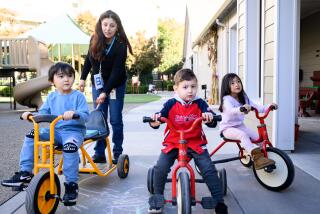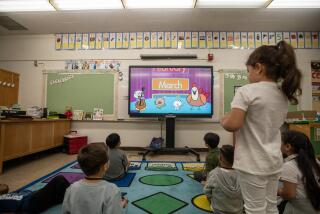Teachers Learn How to Handle Students’ Epilepsy
- Share via
THOUSAND OAKS — Sometimes they seem to be daydreaming. Other times they mumble and their eyes roll upward. And in the worst case scenario, children with epilepsy drop to the ground, cry out and jerk their bodies uncontrollably.
While most teachers know what a convulsive seizure looks like, they may not know how to identify a non-convulsive seizure. During a workshop by the Epilepsy Foundation this week, about 25 Wildwood School teachers learned how to recognize and respond to different types of seizures.
The foundation recently launched its “Be Seizure Smart” program, which aims to teach school staff about the disorder and to make school a safer place for children with epilepsy.
“The children feel isolated and feel a social stigma,” said Susan Pietsch-Escueta, executive director of the regional Epilepsy Foundation based in Los Angeles. “And that’s because people don’t understand epilepsy. If we increase understanding and knowledge about epilepsy, then there will be nothing to fear and the stigma will be reduced.”
Foundation representatives developed a curriculum and are using it to conduct workshops at schools throughout Ventura, Los Angeles, San Bernardino and Orange counties. The seminars target teachers, nurses, special-education staff and principals.
Epilepsy, a neurological disorder that has no cure, manifests itself in recurring seizures. Though there are different types of seizures, they are all caused by a brief malfunctioning in the brain’s electrical system. Epilepsy is not contagious, and medications are available to control seizures.
One neurologist compared the malady to tossing pebbles or boulders into a small body of water. A non-convulsive seizure is like a pebble causing a light ripple; a convulsive one is like a boulder creating a wash over the child’s neurological pool.
About one in every 100 children has epilepsy, according to the foundation. That means there are probably more than 1,300 children in Ventura County schools with the disorder. By taking anti-seizure medication, most of these children attend regular schools and live normal, active lives.
Seven-year-old Patrick Zindrick is one of those children. Patrick, who was diagnosed with epilepsy when he was 16 months old, had regular seizures throughout his early childhood. During that time, Lisha Zindrick was terrified that her son would have a seizure and the teachers wouldn’t know what to do.
“In preschool it was a problem,” she said. “I would tell his teacher what the seizures looked like, and I saw the look of absolute horror on her face.”
Since Patrick has been at Wildwood, his seizures have been under control. But Zindrick still worries. So she does whatever she can to educate his teachers about her son’s disorder, and about his associated learning disabilities that have hampered his progress in reading and grasping basic math skills.
At the beginning of the workshop, program coordinator Joan Spellman asked the teachers whether they had ever witnessed a seizure. More than half raised their hands. And during the hour, they watched a short video, received “seizure emergency plans” and learned how to reassure other students in the event of an episode.
“The first thing you should do is stay calm,” Spellman said. “And by staying calm, you set the tone for the people and students around you.”
Though there is no treatment for a non-convulsive seizure, which might produce mild tics, excessive blinking or a blank stare, teachers should notify the parents when their child has one while at school.
If a student has a convulsive seizure, however, teachers should protect the child’s head by putting something soft under it and by moving any sharp objects. They should also turn the child onto one side to keep his or her airway clear, and should never put anything in the child’s mouth or try to restrain the child.
And if the seizure lasts more than five minutes, the teacher should call 911.
“Having a class like this is really important,” said Julia Yesionek, who teaches third grade at Wildwood. “I feel better knowing what to do. In addition to controlling the seizure, I would be concerned about controlling the class and about making sure the child didn’t wake up with a class of kids peering over him.”
School staff who participated will receive a certificate of completion from the Epilepsy Foundation.
For more information, call the Epilepsy Foundation at (800) 564-0445.






